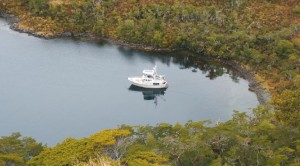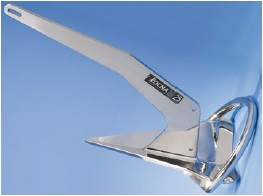If I had a dollar for every hour I spent awake nervously monitoring my plough anchor during the night, I’d be a very wealthy man. Unfortunately, this sleep deprived sacrifice is just part and parcel of boating, right? Well, to some degree this will always be the case. However, anchoring technology has come a long way over the past decade and the majority of new designs are finally providing some relief and peace of mind for discerning boat owners, including me.
I’m sure every boater who has spent some time cruising would agree that choosing the correct ground tackle is as important as the macerator pump’s continuing to macerate. And if you only knew the consequences of a failed macerator on my vessel, you’d realize the importance of the ground tackle. It continues to amaze me when I witness often new, 20m + vessels that have anchors more suited to my nephew’s 4.3m runabout. Obviously, this type of boat owner has never spent a night on the pick with 50 knots across the bow.

This said, it’s often the manufacturer looking to save a few dollars who dictates the ground tackle spec. Can you imagine the consumer outrage if an automobile manufacturer released a vehicle with a critical safety concern?
Recall, recall, recall. So why is it that the marine market accepts anchor sizes, and designs, that should (at best) be packaged into a time capsule and transported back to the 1970s? You wouldn’t have a GPS with 30 year old technology on board now, would you? So it perplexes me as to why boat owners are content to settle for 30-year old anchoring technology when it is such a critical component for their families’, and vessels’, safety.
I can’t give an exact figure of the number of anchor tests that have been completed around the world over the past few years; needless to say, there have been plenty. Although results have been somewhat mixed amongst the various testing criteria, a clear message has been conveyed in every single test; new generation anchors completely out-perform the traditional designs of the CQR, Bruce and Delta. To be clear, the new generation designs have completely moved away from the plough shape and design.
Ode to the Plough
Let’s consider a plough for a moment. It was designed as a farming tool for initial cultivation of soil in preparation for planting seeds. Its shape means it has very little of the surface area needed for high holding power. The plough anchor is designed to land on the bottom, fall on its side, drag, and eventually generate enough holding surface area on the base to corkscrew itself around and hold the boat. Oh, and I should mention that unless you’ve allowed a minimum of 5:1 scope you’ve got about as much chance of getting that plough to set as you have in picking the numbers for Lotto.
I think every proud plough owner would agree that the secret to successfully setting the plough is laying out enough rode. Don’t get me wrong – I’m a huge advocate for dumping everything that’s sitting in your chain locker. But in a crowded anchorage when that isn’t an option, you need an anchor you can trust, with minimal scope, and with the ability to set fast. Further to this, it’s a matter of responsibility. Too many times I’ve had to dodge vessels “on the drift” because of a lack of experience and/or what I call anchoring negligence.
New Generation
New generation anchors are typified by their base design being similar to a spade or shovel. Now if you want to simplify things completely, imagine digging a spade into the ground and dragging against it. It would be near impossible to move due to the surface area it creates. In contrast, a plough would pull straight through the dirt with a relatively small exertion of force applied. I don’t mean to state the obvious, but it’s the same principle under the ocean floor.


Recent independent testing has shown that the new generation anchors have far greater holding power than the traditional plough type anchors. The top three of the new generation designs include the Ultra, Rocna, and Manson Supreme. There has been much debate about which of these three anchors has the highest holding power and fastest setting ability, but it can be best described as a Lamborghini versus a Ferrari versus a Maserati (in no particular order); you wouldn’t mind having any one of the three in your garage.
I’m yet to chat with any boater who jumped off the cliff, purchased a new generation anchor, and is now unsatisfied. In fact, as I understand it, at least two of the new generation anchor manufacturers offer a money back guarantee – so what have you got to lose? Of course, it is important to remember that the purchase of a new generation anchor will not instantly guarantee a peaceful night’s sleep, or a securely set anchor. Other factors must be considered, such as appropriate chain size, scope, bottom type and of course, the skipper’s ability.
Don’t just take my word for it. Have a chat to your fellow boaters who have taken the leap of faith and have never looked back. Ask them about their newfound confidence when it comes time to drop the pick and have a kip. Ask them about the time boats were dragging around them and they were the only vessel to stay put. Most importantly, ask them where they purchased it, so you too can join the ranks and enjoy a decent night’s sleep.




